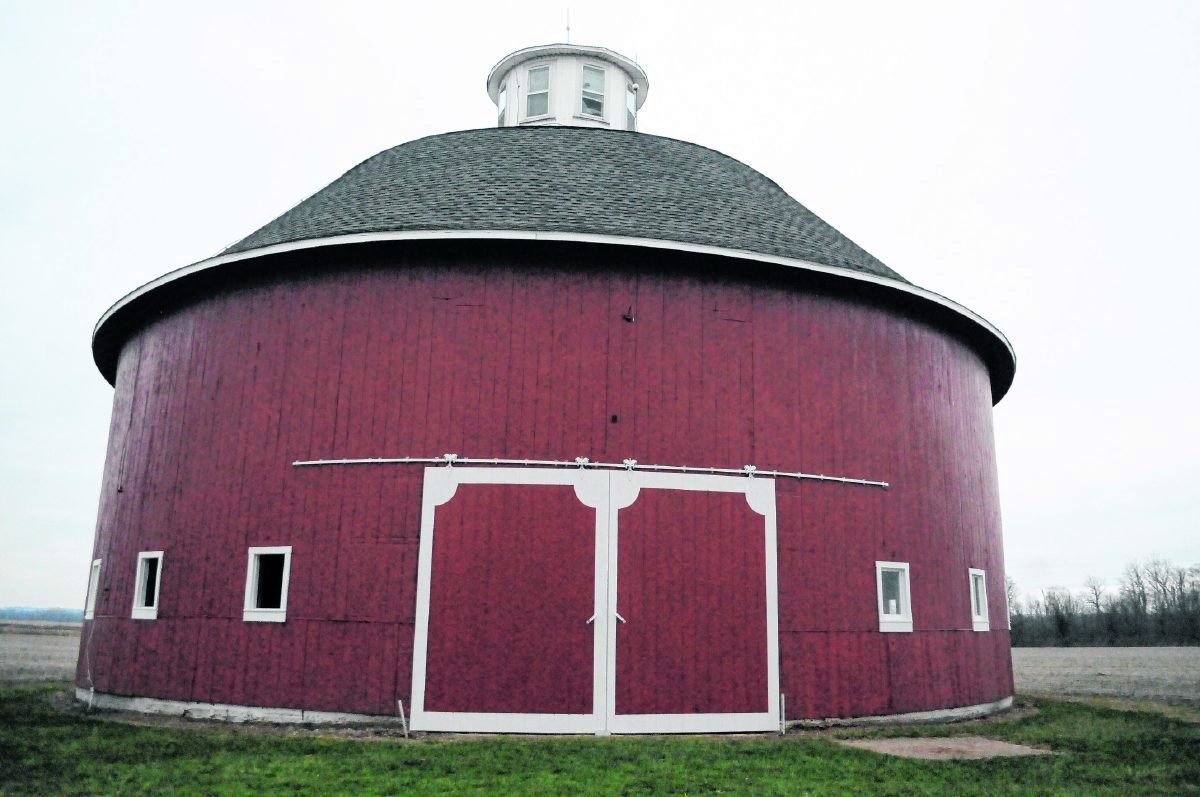
Before the end of the year, efforts to preserve Jackson County’s last round barn will be nearing completion.
The Stuckwish Round Barn at 4400 S. County Road 460W, Vallonia, was built in 1911 for a mere $1,500. It was originally owned and constructed by George Stuckwish with foreman Daryl Carter. Ownership would later go to his grandson, Donald Stuckwish, and the current owners are his nieces, Rebecca Pownall and Barbara Grassl.
After the collapse of the Smith-Hall Round Barn in Carr Township in 2019, the Stuckwish Round Barn became the only one left in Jackson County and one of just 36 in Indiana.
[sc:text-divider text-divider-title=”Story continues below gallery” ]
Click here to purchase photos from this galleryThe barn has two floors and is 60 feet in diameter with a self-supporting two-pitch gambrel roof. Beech is used for most of the woodworking of the barn with pine only used for siding. The beech wood came from the Ewing Sawmill in Brownstown, which is no longer in operation.
The current renovations of the barn are being funded by Pownall and Grassl, said Roger Wischmeier of Seymour.
“The barn is in excellent shape by doing this,” said Wischmeier, who has been supervising the renovations and has been working on the project for a couple of years. “It can stand another number of years.”
Wischmeier said termite damage and rotting wood in the infrastructure on the bottom half of the barn motivated the owners of the barn to “preserve it as much as they can.”
“If we’d let (the barn) go another five years, it would not be standing just from the rot and deterioration of the bottom side,” he said.
Ruben Schwartz of Schwartz Barn and Restoration in Geneva has been doing the renovations.
Those renovations include replacing the sill plates to reinforce the barn’s infrastructure, adding new windows and window siding and repainting the barn red.
Red was chosen for the repainting because that’s what color the barn was when it was originally built.
Schwartz said the new color of the barn was selected to best replicate the original color of the barn based on an old photograph. The barn had been painted white at some point in the past century.
Improvements also have been made to prevent flooding to preserve the interior of the barn.
Schwartz said the process in renovating the barn required more effort than usual for him, but it was a “really great barn to work on.”
“We’re fixing anything that could possibly be bad on the barn,” he said. “The barn is fixed up like it’s new.”
The biggest hurdle involved the wood on the bottom half of the barn rotting away, he said.
The remaining renovations include repairing the windows on the cupola, repainting the cupola red, adding a stairway for access to the second floor of the barn and adding railing on the second floor to prevent people from falling.
Wischmeier said renovations would be complete possibly by the end of the year.
After renovations are done, he plans on cleaning up the inside of the barn.
The hope is schools will utilize the barn to show kids “how awesome it is,” Wischmeier said.
“Kids can look at the structure and learn what it took to build something like this,” he said.
The owners of the barn plan on having an open house to the public with a tentative June 2021 date in mind, he said.
Besides the Smith-Hall Round Barn, there were at least two other round barns in Driftwood Township.
The Burcham Round Barn, located on State Road 135 south of Vallonia, collapsed in 2009. There also was a second round barn near the Stuckwish Round Barn. That round barn, known as the Mahan Round Barn, was destroyed by fire in November 1983.
It was originally owned by John Mahan but was owned by Kenneth and Lloyd Stuckwish at the time of its demise. When it existed, the pair of barns were known to be the only round barns in the United States to be within sight of each other.
Round barns were predominately constructed between 1889 and 1936 in the Midwest. They were cheaper, multifunctional and had more open interiors, making them more efficient than rectangular barns of the time.
Another advantage of round barns was the amount of hay that they could store. When the Mahan barn was destroyed, approximately 2,000 bales of hay were lost.
